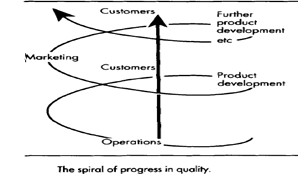SKEDSOFT
Introduction:
Juran has contributed as much to total quality as Deming. He was awarded over thirty medals, fellowships, and honorary memberships in some twelve countries. Quality, according to Juran, has to be controlled at each stage of the process but should not be implemented just as a mechanical process.
Juran’s quality approach:
Juran’s approach to Quality Control and its management is two-sided:
(i) Companies’ mission in terms of fitness for use by providing products and services which conform to customer specifications, plus issues of reliability, availability, maintainability, customer service, etc.
(ii) The role of senior managers in providing leadership, in providing the required resources, in encouraging awareness and participation and in developing systems of policy, goals, plans, measures and controls for quality.
The spiral of progress in quality:
Fitness for use is achieved by a process which reflects the interplay between the various stages or organisational activities before meeting customer demands. The spiral of progress reflects the chain of user-supplier relationships at various stages of the process. Quality, according to Juran, has to be controlled at each stage of the process but should not be implemented just as a mechanical process. It should be aimed at controlling:
- Sporadic problems or avoidable costs (defects and product failure, scrapped materials, labour wasted usage for re-work, repair, dealing with customer complaints);
- Unavoidable costs dealing with chronic problems (prevention and control).
Juran’s quality trilogy:

1. Quality planning
Identify the customers
Determine the customers’ needs
Develop product features
Establish quality goals
Develop a process
Prove process capability
2. Quality control
Choose control subjects (what to control)
Choose units of measurement
Establish measurement
Establish standards of performance
Measure actual performance
Interpret the difference (actual versus standard)
Take action on the difference
3. Quality improvement
Prove the need for improvement
Identify specific projects for improvement
Organise to guide the projects
Organise for diagnosis - for discovery of causes
Diagnose to find the causes
Provide remedies
Prove that the remedies are effective under operating conditions
Provide for control to hold gains